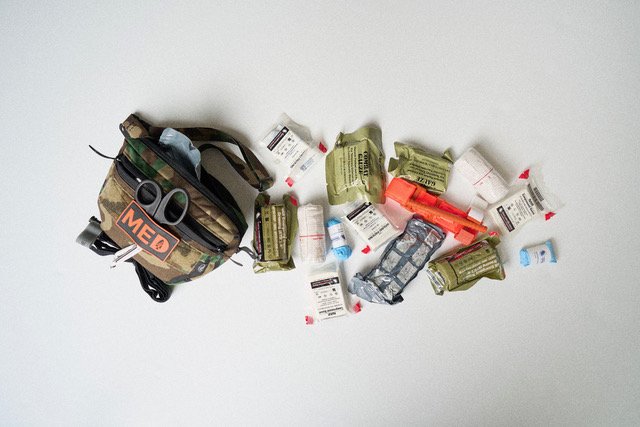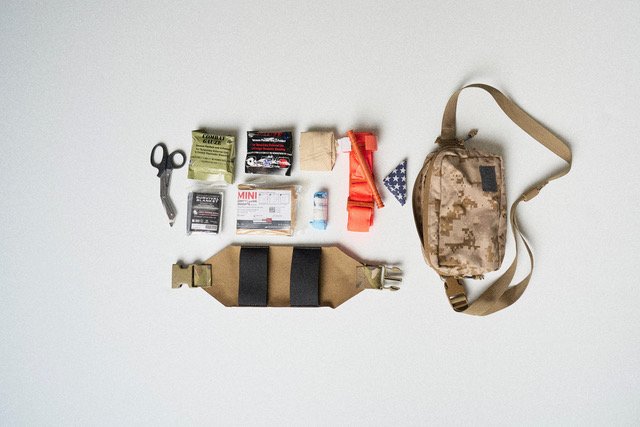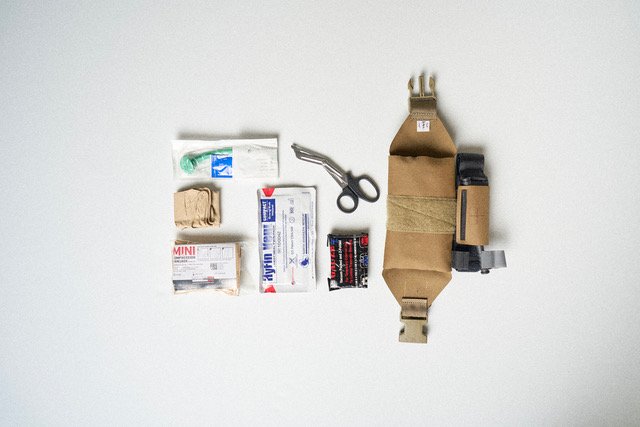Intro to TCCC
Stay prepared for any emergency medical situation
It’s nearly universal that at some point in your life, regardless of circumstance, that you will encounter a medical emergency. This could happen to you or someone around you. This could be an emergency caused by external, physical trauma or a more internal medical event such as a heart attack, stroke, or choking. The last thing you want to be in these situations is unprepared and underequipped.
Core Vision Training’s medical expert is going to cover the basics of the training you should have and the gear you should have at minimum.
Training
As the lead for Medical at Corevision, I’m biased in thinking that it is the most important thing we teach. As stated above, you are more likely to encounter any medical scenario then you will have to clear a house or use your weapon in self-defense, though those are still good skills to have.
But even if you just shoot for fun, you should be able to deal with any consequences that may happen at the range.
Basic Trauma Response - Stop the Bleed/Tactical Combat Casualty Care/ Tactical Emergency Casualty Care are all approaches to medical response to traumatic situations where there is some form of active/passive threat to the patient or the responder.
Tactical Combat Casualty Care was established by the Department of Defense using the lessons learned on the battlefield and implemented throughout the military to come up with a standardized approach to trauma patient assessment and treatment. The implementation of this has saved countless lives and it has been implemented stateside. Usually true TCCC classes are limited to DoD or government agencies.
Stop the Bleed is your basic course for trauma response and covers how to tackle life threating hemorrhage (bleeding). It starts with the ABC’s (Alert, Bleeding, Compression). Calling 911, identifying and assessing bleeding, and compressing the bleed with tourniquets, wound packing, or direct pressure. Stop the bleed if often taught for free at hospitals, fire stations, or community centers.
Tactical Emergency Casual Care is first responder/law enforcement application of TCCC principles. There are a lot of carry overs from the TCCC guidelines, but some small nuances as one is removed from the battlefield. TECC has a civilian component as well as a law enforcement component and is often taught through larger agency or certifying institutions.
Stop the Bleed/TCCC Primer – This is Corevision’s offering into basic trauma response. It covers all the applicable TCCC principles at the basic/good Samaritan level so that you can be an asset in a traumatic situation. We cover the entire American of College of Surgeons Stop the Bleed curriculum and provide certification at the end of the course as well as providing the students to participate in simulated trauma lanes using real equipment and moulage. We also cover the differences between a medical emergency and a trauma emergency. Our Active Defense class is a combination of our CQB primer class and TCCC Primer classes back-to-back.
Basic Lifesaving/Medical Response (CPR, AED) - These courses teach you how to reliably respond to non-traumatic life threatening emergencies such as heart attack, choking, stroke recognition, and opioid overdose. They cover AED and how and when to perform high quality CPR. These are all very likely scenarios one could encounter in daily life and to be a well rounded responder it’s best to have both the trauma and life saving training. These courses are often taught by the American Heart Association or the Red Cross and provide students with certification card. At Corevision we offer courses that teach the response to medical emergencies and how to follow the recommendations laid out by these entities, but do not currently offer certification cards at this time.
MARCH Algorithm Breakdown
If you take one of our classes at Core Vision Training, another TCCC/TECC class, or are around the “tactical” space you probably have heard the word – MARCH thrown around. MARCH is an pneumonic to be able to systematically work through a traumatic situation by identifying and treating life threats based on priority.
In a civilian trauma setting you might see these referred to as the ABCs or XABCs. We don’t care which one you use, just that you develop a systematic approach and foundation to responding to these situations. These are the building blocks and fallback points in tough situations, but not the bible. Use your brain and your tools and once you have the repetition and knowledge down you can deviate from them as needed.
MARCH breaks down as follows
Massive Bleeding
Airway
Respirations
Circulation
Hypothermia
This boils down to what will kill your patient the quickest in a trauma and what we need to address first. In truly life threatening bleeding you have seconds to act. Airway issues you have minutes. Respiratory issues generally are emergencies in slow motion. We want to be on top of them, but have some time to work. Circulation is assessing and treating and preventing shock and hypothermia is keeping our patient warm. As a patient loses blood, there ability to maintain their temperature, oxygen delivery, and clotting cascade diminishes.
This is something we cover in depth at our STB/TCCC and Active Defense classes.
Our partners over at SpecialOperationsMedicine have developed a guide called the In Extremis Guide In Extremis Guide — SPECIAL OPERATIONS MEDICINE to help walk someone through the algorithm.
Basic IFAK kits and Requirements
Let’s take a look at the basic IFAK requirements.
What is an IFAK?
IFAK stands for individual first aid kit. The goal of an IFAK is to be able to treat yourself in response to a life-threatening traumatic injury. The components are stop-gaps to keep you alive and get you to the hospital. IFAKs can scale up or down based on one’s medical knowledge or capability/certification. However, the basic components at bare minimum should be:
Tourniquet – Use only CoTCCC approved devices. These have some testing, evidence and demonstrated use behind them. The guidelines do change, but the latest equipment update from the CoTCCC was in 2021. Buy your tourniquet directly from the manufacturer or reputable dealer only. Do not buy from Amazon.
We do not recommend Snakestaff Systems, RATS, SWAT-T at this time.
See the list of CoTCCC approved devices below
Gauze- Preferably hemostatic such as QuikClot, CombatGazue, Celox or Chitogauze.
I’ll be honest this stuff is expensive, but will give you an extra edge compared to untreated gauze. However, regular gauze will do the job nearly as well. I would much rather prefer to have 10 rolls of regular gauze versus 1 of hemostatic gauze. Generally this is what you get for the same price. You are much more capable an able to respond to contingencies with more equipment.
Ace-Wrap – 6inch – cheap, and effective. This secures your gauze in place should you use it and helps to create the pressure dressing to maintain compression on bleeding. Ace wrap can also be used in numerous other ways to treat patients.
Trauma shears – Don’t be ridiculous with these. The 100 dollar ones are nice, but you will likely use these once when treating someone and leave them behind in the chaos. Spend the extra money on more tourniquets and other equipment
Space Blanket – Hypothermia is a silent killer in trauma. We cover this more in depth in classes or potentially a later post. In short keeping your patient warm when they have lost blood is critical to them having a good outcome.
Gloves - It's important to protect yourself in these situations. My rule is treating any stranger, gloves are non-negotiable. For friends and family, if time is of the essence, I may do without any gloves. It is also important to have light colored gloves so that you can actually identify bleeding. “Tactical” colored gloves look colorful but could impair your ability."
Something to carry this all in – Generally these are vacuumed sealed, in pouches, or pockets. Come up with something that is noticeable, organized, and easy to deploy so that you can find and use your tools efficiently when you need it.
You’ll notice we left out things such as NPAs, 14 gauze needles, and chest seals. These are all common components of military/LE kits. Simply, for inserting airways and performing needle decompression you need training, and some certification to be able to use them.
While they are great life saving tools, we don’t recommend the everyday citizen carry them because if you don’t have the proper certifications to utilize these things you will generally not be covered under good Samaritan laws. As for chest seals, there is not a lot of evidence that they work to decrease morbidity and mortality in trauma patients and you can potentially create a worse problem for your patient and yourself.
More on both in a later post.
Build Your Own Versus Pre-Made Kit
Generally it’s a little cheaper to build you own kit using the list above. However, if you want excellent pre-made kits. Here are the ones we recommend:
AFAK — Core Vision Training – Aptus Atak. We sell this directly on our website. It has everything you need in one kit.
K.I.S. Med Pack V2 - Guerrilla Tactical – This is a more low-vis option/EDC that has addons for gauze, gloves. You will still need to have a tourniquet somewhere on you
Responder IFAK – Live The Creed As with most premades this comes with a little extra (NPA, chest seals).
Bleeding Control Kit | Trauma Kit – Phokus Research Bleeding Control Kit. Everything you would need in once place.
Individual Bleeding Control Kit - Nylon | North American Rescue – Comes with everything you need and a pouch.
Med 101 Wrap Up
In summary, get trained medically. You don’t have to be an absolute surgeon, but you need to know your gear and how to use it. Be an asset. Take a basic course from us or an advanced course from someone like @SpecialOperationsMedicine. If you can’t take one from us, take one from other reputable companies that operate in this space.
Check out Core Vision Training’s shop, Instagram, and other blogs!
@SpecialOperationsMedicine



